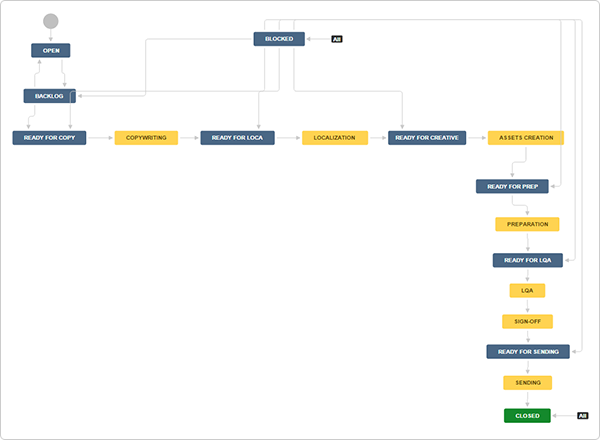Aeria Games has one of those good problems: they’re growing. Fast. But as the company grows, and more teams are formed, the demand for a way to manage all their projects is growing, too. Fed up with too many spreadsheets and emails, not to mention lack of process, one marketing manager recently raised his hand and said, “Stop! There’s a better way.”
You’re about to see how Aeria Games’ marketing team built a marketing workflow to reduce process complexity when collaborating with other teams in other departments.
Visualizing the workflow
The product marketing manager teamed up with Radoslaw “Radek” Orszewski, the global Jira admin and team leader for project and program managers. They pulled together all the stakeholders typically involved in their most complex, multi-team process – sending a newsletter. This included the head of localization and localization managers, the technical marketing manager, the project manager from creative services, the project manager for localization QA, and the marketing copywriter. The pitch to the team was simple: let’s get everyone using a single workflow in Jira to simplify the newsletter process and increase transparency.
Get the marketing workflow ebook
“We got everyone in one room. In response to the idea, some said, yeah this is pretty much against the way we worked before,” said Radek. “But they saw that there’s a synergy and benefit for everyone, with one request that goes across all departments and everyone will see precisely where we are with each request.”
So the team began whiteboarding.

“We started with a session in front of a big whiteboard. When everyone was drawing their own arrows and their own symbols, so everyone could understand who’s the owner, when, what is the idea, and what’s your workflow,” said Radek.
There were some concerns about the process from the stakeholders, whether it was linear, or if the restrictions of the workflow would be limiting. But in the end, the team agreed on the final workflow, stating that 85% of requests would go through it, and that was a good start.
Prototyping the workflow
After the initial brainstorming meeting, Radek collected “fields” from the teams and asked them to document and describe how they developed things like their creative briefs or ad banners. He parsed through the requests and found common terms that would work for all marketing requests, across all pertinent departments.
“This was the biggest challenge of all as each department requires very different information to do their work. Our main task was to identify the absolute necessary information needed by each department to complete their part of the task, while also trying to keep the number of fields a requestor had to fill out to a bare minimum,” said Rachel Gillis, PM for the creative team.
The team then developed a prototype of the marketing workflow using Jira and shared it with the team, showing screenshots of the ticket during each status of the workflow.
“We knew there were going to be some iterations, and change requests, but in the end, they all said yeah, let’s go,” said Radek.
This is the workflow they ended up implementing and is still in use today:
One size doesn’t fit all
Not all workflows need to have this much granularity. For example, the community development team decided they wanted in on the action and built another workflow to fit their needs for managing external communications and social media. It looks like this:

They customized the fields in the ticket to fit their teams’ specific needs, capturing only the most important information for community development projects.

One set of tools
Jira is at the center of Aeria Games’ work processes. All departments use it, even though the level of adoption is quite different. Radek’s team has begun to set up workflows for other non-technical teams, too, including HR.
To continue improving, they have a group of volunteer employees called the Jira Jedis and the Confluence Champions, that spread the use of Jira, Confluence, and Hipchat to all teams. The Jira Jedis are Jira experts/admins in departments other than IT that collaborate on Jira issues to improve their use of Jira. Each team is encouraged to create their own workflows and administer their projects in the way that makes sense for them. Confluence Champions are a new group with representatives from every department defining how to implement Confluence across the company.
They are also avid Hipchat users.
“Jira is the tool that reflects the way we work, not forcing us to work the way the tool tells us to, and I think this is the most important,” said Radek. “Using one tool or one set of tools across the company for different initiatives finally gives you some transparency to see what is actually going on in the company.”
